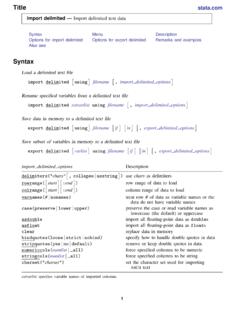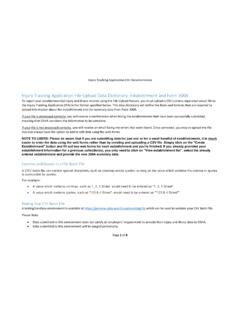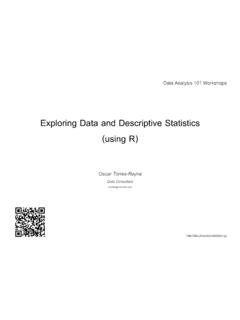Transcription of PYTHON II: INTRODUCTION TO DATA ANALYSIS WITH …
1 Dartmouth College | Research ComputingPYTHON II: INTRODUCTION TO data ANALYSIS WITH PYTHON What is PYTHON ? Why PYTHON for data ANALYSIS ? Development Environments Hands-on: Basic data Structures in PYTHON , Looping Defining a function in PYTHON Importing a dataset in to a PYTHON data structure, using modules PYTHON scripts and parameters Questions, Resources & Links OVERVIEWS oftware Hardware Consulting Training PYTHON is an open-source programming language It is relatively easy to learn It is a powerful tool with many modules (libraries) that can be imported in to extend its functionality PYTHON can be used to automate tasks and process large amounts of data PYTHON can be used on Mac s, PC s, Linux, as well as in a high-performance computing environment (Polaris, Andes, Discovery machines here at Dartmouth)WHAT IS PYTHON ?
2 PYTHON can be used to import datasets quickly PYTHON s importable libraries make it an attractive language for data ANALYSIS NumPy SciPy Statsmodels Pandas Matplotlib Natural Language Toolkit (NLTK) PYTHON can import and export common data formats such as CSV filesReference: PYTHON for data Analytics, Wes McKinney, 2012, O Reilly PublishingWHY PYTHON FOR data ANALYSIS ? PYTHON can be run in a variety of environments with various tools From the command line (most Mac s have PYTHON installed by default) From a windows terminal From a Linux terminal Using an Integrated Development Environment such as Eclipse or PyCharm IDE Using a web-hosted sandbox environment DEVELOPMENT ENVIRONMENTS(I) Browser-based sandbox DEVELOPMENT ENVIRONMENTS (II) Mac Terminal DEVELOPMENT ENVIRONMENTS (III)Entering PYTHON code:Command line or Optional IDEDEVELOPMENT ENVIRONMENTS (IV) PYTHON Integrated Development Environment Materials download: Material reference and basis, PYTHON Software Foundation at.
3 Note about PYTHON and PYTHON : There are a variety of differences between the versions. Some include: Print hi world in is now print( hi world ) in Division with integers can now yield a floating point number In , 11/2=5, whereas in , 11/2= More at SOFTWARE FOUNDATION AND MATERIALS FOR THIS TUTORIAL Preliminary Steps Download data from Dartgolink ( ) Get the dataset to either: A familiar location on your desktop ( ) Or uploaded in to the sandstorm sandbox web environment Opening PYTHON Open your browser to (Create an account or sign in with existing account Or, open a terminal on your Mac or PCHANDS ON PRACTICE: GETTING STARTED Open a web browser Navigate to ON PRACTICE: GETTING STARTEDHANDS ON.)
4 DIVING INMaterials reference: : after typeA line, click Alt+EnterTo run the line and go to next lineUsing a PYTHON interpreter or IDE: # this a comment#Using a PYTHON sandbox, interpreter or IDE: textvar= 'hello world!'print(textvar)# This creates our first variable. It is a string or text variable.#Next, we ll define a variable that contains a numerical value: numbervar= 5print(numbervar)# Create a list BASIC data STRUCTURES IN PYTHON : LISTS# A listinPythonabasicsequencetypesquares = [1, 4, 9, 16, 25]print(squares[2])# Basic list functions: retrieve a value, append, insertprint(squares[1]) (35) # add a value to end of list print(squares)squares[5] = 36 #.
5 And then fix our error, 6*6=36! print(squares)This is where the sandbox environment, or an IDE, becomes very useful# a basic conditional structureBASIC data STRUCTURES IN PYTHON : LISTS WITH CONDITIONALSif 0 == 0: print( true )# used with a list elementif squares[1] == (2*2):print('correct!')else:print('wrong ! )squares[:] = [] # clear out the list#Loop over a data structureberries = ['raspberry','blueberry','strawberry ]#Loop over a data structureberries = ['raspberry','blueberry','strawberry']fo r iin berries:print("Today's pies: " + i)# sort the structure and then loop over it for iin sorted(berries):print("Today's pies(alphabetical): " + i)LOOPINGOVERABASIC DATASTRUCTUREA Tuple is a type of sequencethat can contain a variety of data types# Create a tuplemytuple= ('Bill', 'Jackson', 'id', 5)Print(mytuple)# Use indexing to access a tuple element.
6 Note: tuple elements start counting at 0, not 1 mytuple[3]BASIC data STRUCTURES: TUPLES AND SETS# Create a Dictionary or look-up table# The leading elements are known as keys and the trailing elements are known as values lookuptable= {'Dave': 4076, 'Jen': 4327, 'Joanne': 4211}lookuptable['Dave']# show the () ()# check to see if an element exists'Jen' in lookuptable# output: true BASIC data STRUCTURES: DICTIONARIESC reate a Dictionary or look-up tableUse the key for error-checking to see if a value existsleading elements are known as keys and the trailing # check to see if an element existsif 'Jen' in lookuptable:print("Jen's extension is: " + str(lookuptable['Jen ]))else:print("No telephone number listed")BASIC data STRUCTURES: DICTIONARIES# Loop over a dictionary data structure#printthewholedictionaryfor i,jin ():print i,jDATA STRUCTURES: LOOPING Use a while looptogenerateaFibonacci seriesWHILE LOOPS AND LOOP COUNTERSa, b = 0, 1i = 0 fibonacci = '1'while i < 7.
7 Print(b)fibonacci = fibonacci + ', ' + str(b) a=bb=a+b i=i+1 # increment the loop counterprint(fibonacci)Modules greatly extend the power and functionality of PYTHON , much like libraries in R, JavaScript and other languagesimport sys# check the version of PYTHON that is installed ' (default, Oct 8 2014, 10:45:20) \n[GCC ] in this sandbox!# check the working directoryimport ()'/var/home this is less applicable in the sandbox on laptop or a linuxserver it is essential to know the working directoryIMPORTING AND USING MODULES# multiply some consecutive numbers 1*2*3*4*5*6*75040# save time and labor by using modules effectively import (7)IMPORTING AND USING MODULESMODULES# Modulesfrom math import pi print(pi)round(pi)round(pi,5)Functions save time by storing repeatable processesDefining a function is easy:use the def function in PYTHON def xsquared( x ):# find the square of xx2 = x * x.
8 # the return statement returns the function valuereturn x2# call the functiony = xsquared(5)print str(y)# Output: 25 DEFINING A FUNCTION IN PYTHONWe ll use the WITH and FOR commands to help us read in and loop over the rows in a CSV file; here s some pseudo-code of what we d like to do: WITH open ( ) as fileobject:{get data in file}FOR rows in file:{do something with data elements in the rows}WITH AND FOR COMMANDS To upload dataintothe hosted PYTHON instance, clickthe jupyter title to go back to upload screen Use the Files tabtoupload Upload>Browse The hosted environment supports the upload of reasonably-sized csv files UPLOAD data Next, let s examine a dataset of patients (rows) and forty days of inflammation values (columns) data ANALYSIS INFLAMMATION DATASET# loadwith numpyimport (fname=' ', delimiter=',') # load csv# load in to a variabledata = (fname=' ', delimiter=',') # load csv to variableprint( data )print(type( data ))prin t( )print( ) import ()f = open(' )filecontent= ()
9 Print(filecontent) View data elements with matrix addressing data ANALYSIS INFLAMMATION DATASET print('first value in data :', data [0,0])print( data [30,20])maxval= ( data )print('maximum inflammation: ', maxval)stdval= ( data )print( 'standard deviation: ', stdval) Next, let s examine a dataset of patients (rows) and forty days of inflammation valuesDATA ANALYSIS INFLAMMATION DATASET import inlineimage = ( data ) Next, let s examine a dataset of patients (rows) and forty days of inflammation valuesDATA ANALYSIS INFLAMMATION DATASETave_inflammation= ( data , axis=0)ave_plot= (ave_inflammation) () Use an IDE or friendly text-editorSCRIPTS AND PARAMETERS #!
10 /usr/bin/ PYTHON #------------------------ --------#myfirstscript!import sysprint('My firstscript!')print('Number of arguments:', len( ), 'arguments.')print('Argument List:', str( ))#-------------------------------- Programming for speed, reusability data ANALYSIS over many files READING MULTIPLE FILESGot lots of files? This is where RC systems like Polaris or Discovery can be very useful strfiles= [' ',' ]for f in strfiles: print(f)# data = (fname=f, delimiter=', )#print('mean ',f, ( data , axis=0))import csvwith open(' ', 'w', newline='') as csvfile:fieldnames = ['first_name', 'last_name']writer = (csvfile, fieldnames=fieldnames) () ({'first_name': 'Baked', 'last_name': 'Beans'}) ({'first_name': 'Lovely', 'last_name': 'Spam'}) ({'first_name': 'Wonderful', 'last_name': 'Spam'})WRITE TO CSV!









